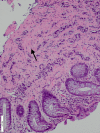Flushing: A Diagnostic Dilemma
- PMID: 34277159
- PMCID: PMC8269976
- DOI: 10.7759/cureus.15515
Flushing: A Diagnostic Dilemma
Abstract
Carcinoid tumors are uncommon tumors that are often diagnosed in later stages of the disease due to their indolent nature, vague clinical presentation and overlap of symptoms with other conditions. We report a case of rectosigmoid carcinoid tumor which was found incidentally on screening colonoscopy in an elderly woman that went undiagnosed for several years due to confounding effects of symptoms of post-hysterectomy menopause with that of carcinoid syndrome. Persistent episodic flushing with or without diarrhea not resolved with standard treatment should lead to suspicion of neuroendocrine tumors (NETs). This case report emphasizes the need to broaden our perspective of menopausal symptoms and pay attention to the characteristic clinical symptoms of NETs.
Keywords: carcinoid syndrome; delayed diagnosis; flushing; hot flashes; menopause; neuroendocrine tumor.
Copyright © 2021, Ravikumar et al.
Conflict of interest statement
The authors have declared that no competing interests exist.
Figures



References
-
- Leonine facies, flushing, and systemic symptoms. Prieto-Barrios M, Ortiz-Romero PL, Rodriguez-Peralto JL. https://pubmed.ncbi.nlm.nih.gov/28423166/ JAMA Dermatol. 2017;153:925–926. - PubMed
-
- NANETS consensus guidelines for the diagnosis of neuroendocrine tumor. Vinik AI, Woltering EA, Warner RR, et al. Pancreas. 2010;39:713–734. - PubMed
-
- Delays and routes to diagnosis of neuroendocrine tumours. Basuroy R, Bouvier C, Ramage JK, Sissons M, Srirajaskanthan R. https://doi.org/10.1186/s12885-018-5057-3. BMC Cancer. 2018;18:1122. - PMC - PubMed
-
- Clinical presentation and diagnosis of neuroendocrine tumors. Vinik AI, Chaya C. Hematol Oncol Clin North Am. 2016;30:21–48. - PubMed
Publication types
LinkOut - more resources
Full Text Sources
